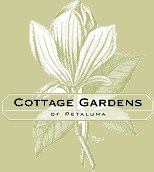
Garlic
Growing It Well
Garlic is a cold season, winter-hardy, easy-to-grow addition to any vegetable garden. October to early November is the time to plant it for the best yields & the highest quality, delicious, fat garlic bulbs. Expect to harvest garlic around June or July. The hardest part about growing garlic is choosing which variety to grow!!
Preparing Soil for Growing Garlic Garlic prefers sandy loamy soil, but grows well in nearly any well-drained, slightly acidic (6-7 pH), fertile soil. The looser the composition of the soil, the larger your garlic will grow. Prepare your garlic bed by turning under or tilling in compost (be sure to use compost that is fully broken down & contains animal manures & plant residues). Make sure your soil has ample phosphorus also. Take care not to plant garlic in the same place you've previously grown garlic or onions, because of the potential for spreading diseases like white rot. Also, gophers love garlic; so protect your beds with gopher wire or traps.
Planting & Growing Garlic If you buy whole garlic bulbs, break the bulb up into cloves & plant only the best & biggest cloves. Each of these cloves will grow into a whole new bulb of garlic. Use the left over small cloves for eating or preserving. Plant your garlic cloves root end (blunt end) down. Plant in rows spaced 18" apart, cloves should be 4" to 6" apart. The cloves should have about 2" of soil over them. If you buy garlic starts, just follow the above spacing instructions. The rest has been done for you.
Mulch It is a good idea to give your garlic 2-4” of mulch after you have planted it. Leaves, compost, or well-composted manure make excellent mulches.
Water the garlic well when you plant it, and keep an eye on the fall & winter rains. Make sure it gets regular hydration & water if the soil goes dry. Remember, garlic loves water & feeding (EB Stone Sure Start or Tom & Veg Food is a great side dressing), but must have good drainage or will rot. Moisture is a more critical factor in the Spring; watch your soil moisture levels & irrigate accordingly.
Feeding In the Spring, feed the garlic with either composted manure or a well-balanced organic fertilizer (EB Stone Sure Start or Tom & Veg Food) before the bulbs begin to enlarge.
Weeds Keep weeds away from your garlic; you either grow weeds or garlic, not both!
Flowering Garlic may send up a flower stalk in the Spring. These curled tops are called ‘scapes' & are extremely tasty - mildly garlicky - when picked young. Use for soups & sautees, or simply as a garnish. Scapes do not appear to affect the growth or size of your future garlic bulbs!
Harvesting Garlic & Storing Harvest when the foliage falls on softnecks, or when the bottom leaves dry out on hardnecks. When garlic leaves turn color Juneish, stop irrigating for 2 weeks, then pull up the plant & immediately put it in a shady place to cure. Do not leave your garlic in the sun, because it will sunburn & rot. A good way to cure garlic is to tie it in bunches or braid it (if it is a softneck garlic) & hang it in a dark place where it will receive good air circulation. Hardneck varieties typically will only store for 6 months or less. You can store your garlic in mesh bags (like onion sacks) in a cool dry area. The optimum storage temperature is 50°F. If some of your bulbs turn out onion-like, that is, they do not divide into cloves, you can eat them or use them as seed for next year .
Yield: Though it varies by variety as to how many cloves per head of garlic, 1 pound of garlic gives you a row 25' long, spaced 4” apart and that 1 pound = 10lbs at harvest time!!!
Click HERE to return to our Vegetable page.